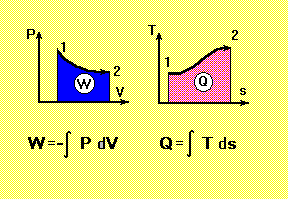Reversibility
Reversibility
In a reversible process the state of working fluid and system's surroundings can
be restored to the original ones. This requires that the working fluid goes through a continuous series of
equilibrium states. A reversible process should satisfy the following criteria:
- No internal or mechanical friction is allowed.
- The temperature and pressure difference between the working fluid and its surroundings should be infinitely small.
There are no truly reversible processes in practice. The real processes are called irreversible. However,
there are some processes that can be assumed internally reversible with good approximation, such as
processes in cylinders with reciprocating piston. The working fluid is always in an equilibrium state in
internally reversible process. But the surroundings undergo a state change that can never be restored.
Some processes may not be assumed internally reversible, such as processes in turbo machinery. The
irreversibility of these processes are due to the high degree of turbulence of the working fluid.
A reversible process between two states may be shown by a continuous curve on any diagram of
properties. Different points on the curve represent the intermediate states.

The work input to a system during a reversible process is:
W= Marked area on the P-V diagram.
and the heat supplied to a system during a reversible process is:
Q= Marked area on the T-s diagram.
Intermediate states for an irreversible process is indeterminate, therefore these processes are often
shown by a dotted line joining the initial and final states.
Copyright © 1998 Taftan Data. All Rights Reserved